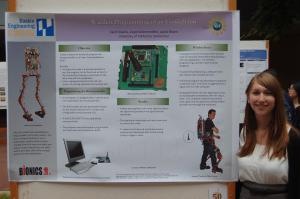Carol Owens: Wireless Programming of an Exoskeleton
| Attachment | Size |
|---|---|
| 1.56 MB |
The lower limb exoskeleton at UCSC (The LEX) was created to help soldiers support heavy backpacks. The exoskeleton uses a pneumatic system to power its movement. The pneumatic system is controlled by an electronic system which is powered by rechargeable batteries. The LEX’s movement is controlled by a program written to the microcontroller. This program takes the angles of the exoskeleton’s legs to determine which part of the walking cycle the user is in, and then distributes air pressure to the hip and ankle at the correct time to propel the wearer forward.
Previously, to change the control program the microcontroller on the LEX had to be removed from the exoskeleton and connected to a computer. My project was to create a system where the LEX could be programmed wirelessly. New programs can now be downloaded to the LEX through a radio connection between the computer and the exoskeleton. This makes reprogramming faster and easier because the exoskeleton can remain on the user while the new program is downloading. The user also does not have to come back to the lab to have the control program changed, making the exoskeleton more portable.
